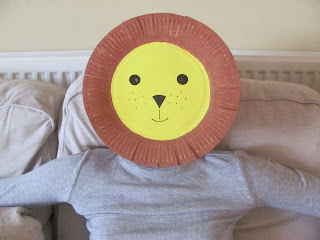Magical mermaids! Always thought the bumpy rim on a paper plate would make a good scaly tail, so that's how this project started..
We used small pieces of sponge to paint her too, which was super quick, great fun and added a bit more texture.
You will need:
Two paper plates (ours were 15cm)
Scissors
Pencil
Craft glue or a glue stick
Paint
Old sponge
Black felt tip or gel pen
1. Draw a pencil line in one of the grooves on the plate rim and roughly mark the middle point of the plate. Count about 10 bumps along and draw another line in the groove. Join the top of these two lines to the dot in the middle of the plate, but curve the lines out a bit, so they're not completely straight (this top part is going to be your mermaid's body)
2. Cut this piece out and then cut the rim away from the centre of the plate.
Cut five pieces from the rim that are about the same size as the rim on the body piece (10 bumps).
Glue FOUR of these pieces to the body (leave one for the end of the tail). Glue them underneath, with the bumps showing. Just concentrate on lining up the top edge, and making a nice curve here for the tail.
Don't worry about the sticky out bits at the bottom! We'll sort those out when the glue dries.
3. While the glue dries, make the head by drawing around the bottom of something like a small spice jar on a spare piece of paper plate centre. Cut it out, and if you want, trim two sides to make a more oval shape (optional).
5. Cut about a third off the head and place it on the hair, so she looks like she's got a fringe (bangs). When you're happy with the position, draw a pencil line right along the top of the head.
Then, roughly halfway along this line, fold the hair piece longways. and either cut straight along the folded line for a straight fringe, OR, as we did, start cutting just above the line, aiming for the end of the line, to make a centre parting!
Make sure the head piece fits in the slot, but don't stick it down yet.
6. To make the arms, draw around the top part of the mermaid's body on some spare paper plate middle. Make sure it's just the top of the body, so only go as far as the first ridge (see picture below). Then join the two ends with a gently curved line.
7. Draw a pencil line inside, mirroring the shape, so it's about 1cm wide (it doesn't have to be perfect!)
Cut the piece out and then snip through the pointy end of the shape, and follow the inside line.
8. Time to finish off the tail! cut away the sticky out bits at the bottom (I've drawn a pencil line, so you can see more clearly what I mean). Then draw a pencil line from the bottom of the second piece of plate rim to the end of the tail, tapering and making it thinner as you do, to make a nice curve. Keep it about a 1cm wide at the end.
9. To make an even looking tail end, draw a pencil line roughly in the middle of the remaining piece of plate rim. Cut away the sides at an angle, so it's the right size to fit on the end of the tail. Then cut out the curvy tail end, using the middle line as a guide. Glue in place.
10. Painting time and we cut small pieces from an old sponge, about 2 to 3cm square. Press them in the paint and get sponging! Use one piece for each different colour.
First we painted the body, head and arms. We mixed lots of white with a little red, dab of yellow and tiny spot of blue.
The hair is a mix of yellow and orange splodges, but do the body and hair whatever colour you prefer.
The tail is green and blue splodges.
Leave your mermaid pieces to dry.
11. Once dry, assemble your mermaid. Slide the arm piece over the body and angle it to one side. Trim the nearest arm, so it doesn't look too long. Make sure the arm piece is 1cm or so below the pointy top and glue in place. Glue the head to the top of the body, and then the body to the hair, sliding the head into the fringe slot.
12. Cut small triangles for the bikini from some leftover rim, and glue them on. Use a black pen to draw on her face.
Obviously add glitter if you want to!
And hang on to the leftover rim pieces. I have some other ideas for them...





















































